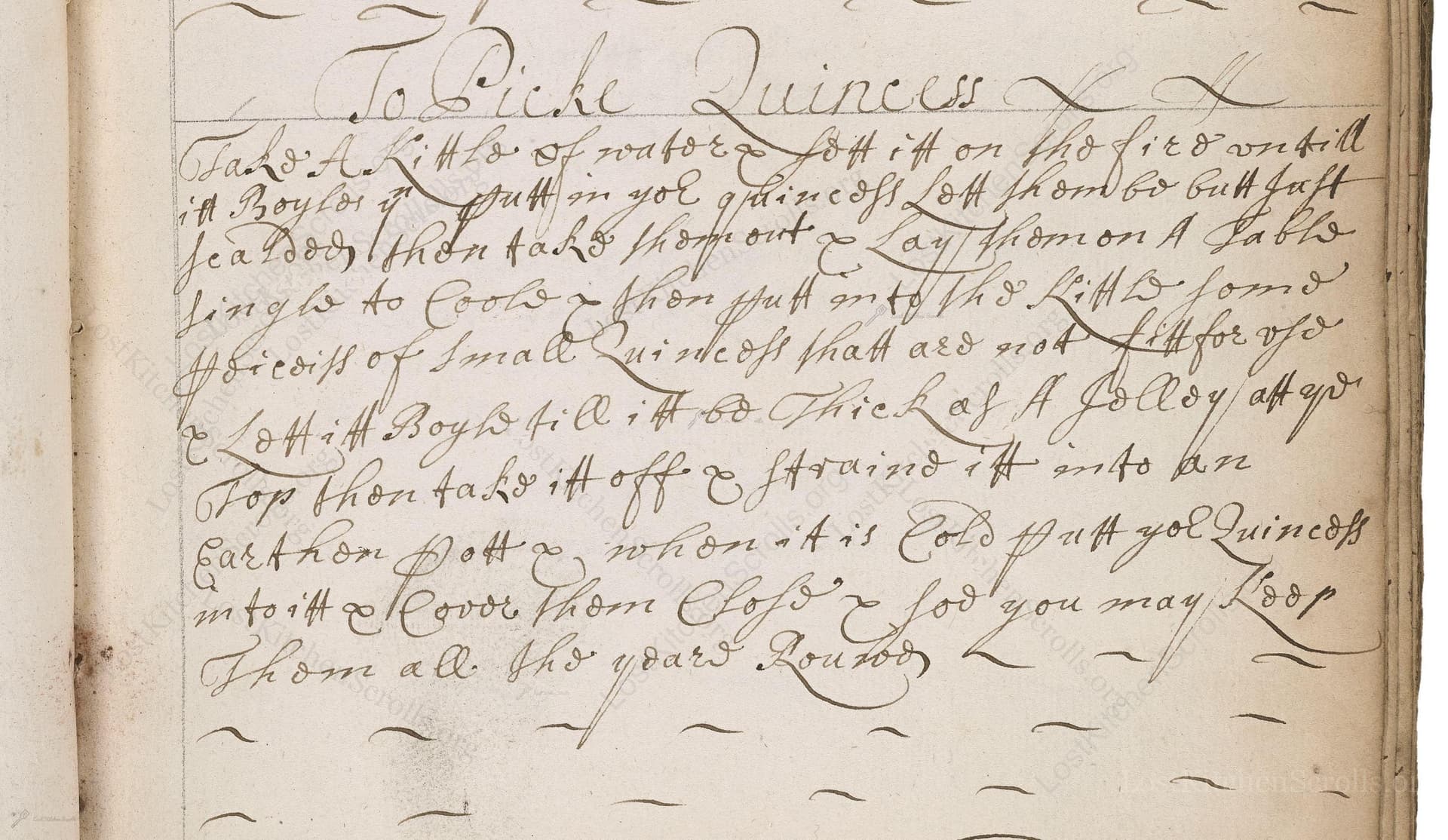
To Picke Quincess
"Take A Kittle of water & sott it on the fired ontill itt Boyles & putt in youR quincess & lett them bo but soft feareing that they boake to peises & Lay them on A Table tring to Coole & then putt into the Kittle some slices of Small Quincess that ard not fit for youse & lett it Boyle till it bo Thick as A Jolley & then Take it off & Strain it into an Earthen Pott & when it is Cold putt youR Quincess into it & Coover them Close & soe you may Keepe Them all the yeare Round."
Note on the Original Text
This recipe, like many from the 17th century, is written in a conversational yet minimal style, providing basic steps but omitting precise measurements, times, or temperatures. Spelling is not standardized (e.g., 'picke' for 'pickle', 'boake' for 'break', 'sott' for 'set'), reflecting the conventions of the period. Such recipes assumed the cook had a foundational knowledge of basic kitchen practice—modern cooks benefit from more specificity, but the spirit and core of the method remain intact.

Title
Cookbook of Ann Smith, Reading (1698)
You can also click the book image above to peruse the original tome
Writer
Ann Smith
Era
1698
Publisher
Unknown
Background
Step into the sumptuous kitchens of 17th-century England with Ann Smith’s culinary treasury, where traditional recipes and time-honored techniques invite you to savor the flavors of history. Each page promises a feast of inspiration and a glimpse into the artful dining of a bygone era.
Kindly made available by
Folger Shakespeare Library
This recipe comes from the late 17th century, attributed to Ann Smith in 1698. At the time, sugar was expensive and pickling or jelly techniques were commonly used to preserve fruit for consumption throughout the year. Quinces, with their high pectin content, lent themselves well to this kind of preparation—it allowed households to enjoy this fragrant fruit long after the harvest ended. This technique also offered a way to use up bruised or less attractive quinces, ensuring nothing went to waste in an era when food preservation was of utmost importance.

The tools used in the past would have been quite simple and practical: a large metal kettle or cauldron for boiling, possibly suspended over an open hearth. A wooden spoon for stirring, a slotted spoon or ladle to remove the fruit, and a table or board for cooling the quinces. A coarse cloth or sieve for straining the thickened juice, and a glazed earthenware pot for storage—tightly covered with a wooden lid, leather, or cloth tied securely.
Prep Time
15 mins
Cook Time
1 hr 15 mins
Servings
8
We've done our best to adapt this historical recipe for modern kitchens, but some details may still need refinement. We warmly welcome feedback from fellow cooks and culinary historians — your insights support the entire community!
Ingredients
- 3–4 pounds fresh quinces (whole, ripe and unblemished)
- 1 pound small or imperfect quinces (for jelly-making stage)
- 3 quarts water
Instructions
- Begin by filling a large pot with about 3 quarts of water and bringing it to a rolling boil.
- Add your whole quinces (around 3–4 pounds), and simmer them until they are just soft—be careful not to overcook, as they may fall apart.
- Once tender, gently remove them onto a clean surface or tray to cool.
- Return to your pot, and add small, sliced quinces (about 1 pound), particularly those that are bruised or imperfect.
- Boil these down in the same water until the liquid becomes thick and syrupy, resembling a soft jelly (this may take around 30–45 minutes).
- Strain the thickened liquid through a fine sieve into a ceramic or glass container, discarding the solids.
- Once the liquid has cooled completely, nestle your reserved whole quinces back into this jelly.
- Seal the container tightly and keep it in a cool place; stored this way, the quinces should last for many months—ideally up to a year.
Estimated Calories
130 per serving
Cooking Estimates
It takes about 15 minutes to get everything ready, and about 1 hour and 15 minutes to cook the quinces and jelly. Each serving has around 130 calories, and this recipe makes 8 servings.
As noted above, we have made our best effort to translate and adapt this historical recipe for modern kitchens, taking into account ingredients nowadays, cooking techniques, measurements, and so on. However, historical recipes often contain assumptions that require interpretation.
We'd love for anyone to help improve these adaptations. Community contributions are highly welcome. If you have suggestions, corrections, or cooking tips based on your experience with this recipe, please share them below.
Join the Discussion
Rate This Recipe
Dietary Preference
Main Ingredients
Culinary Technique

Den Bockfisch In Einer Fleisch Suppen Zu Kochen
This recipe hails from a German manuscript cookbook compiled in 1696, a time whe...

Die Grieß Nudlen Zumachen
This recipe comes from a rather mysterious manuscript cookbook, penned anonymous...

Ein Boudain
This recipe comes from an anonymous German-language manuscript cookbook from 169...

Ein Gesaltzen Citroni
This recipe, dating from 1696, comes from an extensive anonymous German cookbook...
Browse our complete collection of time-honored recipes



